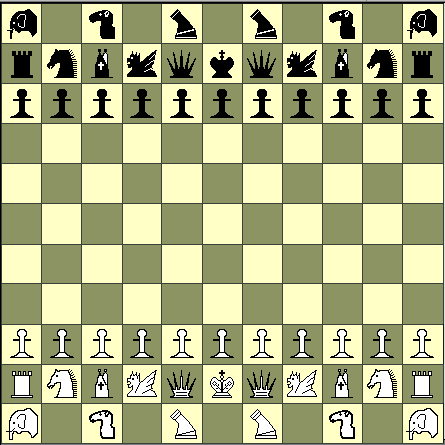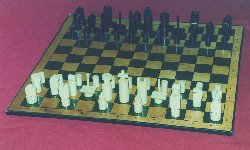Tamerlane II
This Chess Variant is inspired by Timur's or Tamerlane's Chess . It is intended to replace the earlier version of Tamerlane II, which competed in the Large Chess Variant Contest in 1999, with a modest result. Then, several changes have been implemented in an attempt to improve this modern large chess.
Players
Two.
The board has 11 x 11 squares. The 11 files respect the original configuration of Tamerlane's chess with a central king. The 11 ranks give more space to the game allowing to arrange the piece before struggling. Moreover, they place Bishops and Camels on same colors allowing attack of opposite counterparts and mutual protection.
Moves And Captures
King, Bishop, Knight and Pawn are orthodox.
-
Prince: moves one square in any direction, like a King.
Camel: jumps to the opposite case of a 2x4 rectangle. No matter
what intermediate cases contain. The Camel are taken from Tamerlane's Chess.
Elephant: moves 1 or 2 cases diagonally. It can jump over the
first case if it is occupied.
Cannon: moves like a Rook. Takes as in Xiang-Qi:
needs an intermediate piece between itself and its victim. The Cannon jumps
the intermediate and take the victim on its square. The intermediate is
left unaffected.
Ship: move one square diagonally and then, goes away of an indefinite
number of cases vertically, never horizontally. It can move one square diagonally
only. It can not jump and must begin its move with the diagonal step.
The Ship is more limited than the Gryphon from Grande Ajedrez which can move horizontally. Nevertheless its move power is comparable to the Rook and the Bishop. The Ship is inspired by the Giraffe from Tamerlane's chess and the Gryphon from "Grande Acedrex".
There is no Queen at the start of the game. This piece may appear later on by promotion.
Other Rules
- King's Succession: a King in checkmate is lost but this does not constitute the end of the game if its player still has one Prince and that this man is not itself in check. In such a case, King and Prince exchange their positions. This counts as one turn. The checking player is free to take or not the new Prince. This process can be repeated as long as the above conditions are fulfilled. They are a second and a third chance as in Tamerlane's chess.
- Prise en passant: follows the orthodox rules.
- Castling: there is no castling at Tamerlane 2000.
- Pawn's Promotion: the Pawn is promoted to a Queen when reaching the last row.
- Prince's Promotion: a Prince reaching the first opposite row (the 9th rank for White) can be promoted to a Queen.
- Ship's Promotion: a Ship reaching one of both opposite corners (a11 or k11 for White) can be promoted to a Gryphon.
- The Queen is the orthodox one (Rook + Bishop)
- Gryphon : is move one square diagonally and then, goes away of an indefinite number of cases vertically or horizontally. It can move one square diagonally only. It can not jump and must begin its move with the diagonal step. This piece is almost as powerful than the Queen.
End Of Game
Victory is obtained when the opposite King is checkmated with no possibility to be replaced.
All other types of endgame (pat, perpetual check,...) are classic.
Another variant : Wild Tamerlane Chess
The fact that strong pieces can only appear after promotion gives an original taste to this large Chess Variant. However, for those looking for strategies around "bloody" battles, it could be interesting to try a simple variant where Princes and Ship are replaced by Queens and Gryphons from the initial set-up.

Remarks
You can play either Tamerlane 2000 or Wild Tamerlane with the following zrf file designed by Jean-Louis Cazaux. (providing you own Zillions-of-games software.). However, the Prince crowning is not implemented for programming reasons.
Shako and Perfect 12 are two other related game of my invention. Perfect 12 is probably my preferred however.
Differences between Tamerlane 2000 and Tamerlane II
Here is the list of the changes made in this attempt to improve the game:
-
Pawn can promote to Queen on last row. This gives more power to the Pawn.
The rule of promoting to any captured piece is unfair since it is a penalty
for the strong player who still has many pieces on the board. Promotion to Queen
only is an appreciated simplification in this game where there are a lot of
different piece types.
Princes replace Fers and Wazir. It is a good simplification with1 piece
instead of 2 different. Also, the Prince is much more interesting than the Fers
and the Wazir which are very limited and weak pieces.
Princes promote to Queen on 1st opposite rank. The reason is to make this
more likely to happen: the Prince is starting one rank behind the Pawn and can
not benefit from a double step. Then, going to the last row would have been
a too long trip.
Ships can promote to Gryphon on opposite board corners. This gives an
interesting possibility with these pieces which are very powerful longitudinally
but are rather slow to move laterally. Once promoted, the Gryphon is a dreadful
piece which can terminate the game very quickly.
Castling is suppressed. It was very rare anyway since there are 4 pieces
to remove between the King and the Rook.
Non-capturing shift of Bishop, Camel and Elephant is suppressed. It was
an unnecessary complication which made the game very unusual and difficult to
master. Now, the player has just to remember that dark squares are controlled
by the Bishops and light squares by the Camels and the Elephants.
Additional remarks
Below, you find a photo made by Jean-Luc Muraro of the set of this game, designed and made by Jean-Louis Cazaux. If you click on the picture, you can see it in large size.
Written by Jean-Louis Cazaux.
WWW page created June 05, 2000. Modified on March 18 2001, thanks to Ivan A Derzanski for corrections.
Setup
The board has 11x11 checkered squares, with light colored squares at each corner. The 11 files respect the original configuration of Tamerlane's chess with a central king. The 11 ranks give more space to the game allowing to arrange the piece before struggling. Moreover, they place Bishops and Camels on same colors allowing attack of opposite counterparts and mutual protection.

There are 28 pieces per side
White: Elephant a1, k1; Camel c1, i1; Cannon e1, g1; Rook a2, k2; Knight b2, j2; Bishop c2, i2; Ship d2, h2; Prince e2, g2; King f2; Pawn a3 to k3.
Black: Elephant a11, k11; Camel c11, i11; Cannon e11, g11; Rook a10, k10; Knight b10, j10; Bishop c10, i10; Ship d10, h10; Prince e10, g10; King f10; Pawn a9 to k9.
There are 28 pieces per side: 1 King, 2 Queens, 2 Eagles, 2 Bishops, 2 Knights, 2 Rooks,
Notes
Deep thanks to H.G. Muller for making the Interactive Diagram below
 This 'user submitted' page is a collaboration between the posting user and the Chess Variant Pages. Registered contributors to the Chess Variant Pages have the ability to post their own works, subject to review and editing by the Chess Variant Pages Editorial Staff.
This 'user submitted' page is a collaboration between the posting user and the Chess Variant Pages. Registered contributors to the Chess Variant Pages have the ability to post their own works, subject to review and editing by the Chess Variant Pages Editorial Staff.
By Jean-Louis Cazaux.
Last revised by Jean-Louis Cazaux.
Web page created: 2000-06-05. Web page last updated: 2022-12-27
